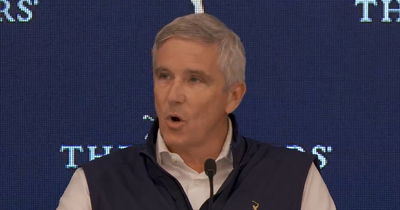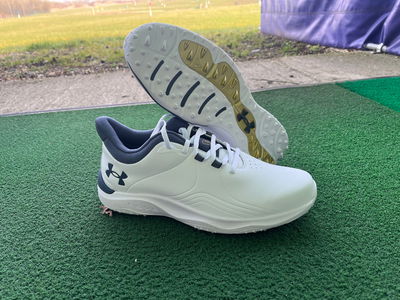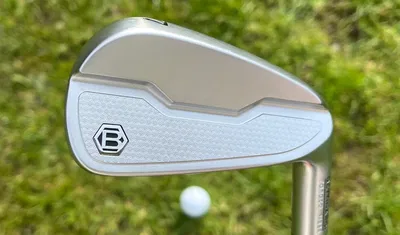Why longer shafts aren't the key to longer driving
Extra length doesn't guarantee consistent distance, says club-maker John Whitehead

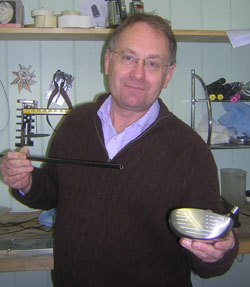 BORDER='1' STYLE='margin-left:10' VSPACE='5' ALT='Golf driver shafts'> |
It wasn’t long ago that the average length of a driver was no more than 43.5 inches. But times have changed and when next you look over the clubs in your local pro shop or golf superstore, pay attention to the length of the drivers of your favourite brands.
You’ll find them built to a length of 45 to 45.5 inches which now seems to be the standard length of modern off-the-shelf drivers, regardless of brand. You’d be forgiven for believing that this is not only normal but quite usable for the average golfer. But everything in life - and golf - is not always as it seems.
So what’s the reason for this increase in driver length? It’s certainly not that the average golfer has become taller and more athletic in the last 20 years!
There are two reasons. The first is technical because when graphite became the preferred shaft for drivers, its lightness caused problems on the production lines. It dramatically altered the feel of a 43.5-inch driver, reducing the swing-weight by some nine to 12 points making a men's driver feel more like a woman's.
There where three ways to resolve problem:
1) Return to fitting heavier steel shafts
2) Re-work driver heads by adding weight
3) Leave two inches extra on the shaft
The other reason (apart from technical) is the quest for distance by the club golfer. But first I should mention that US PGA Tour statistics reveal that the average length of a Tour player's driver is 44.5 inches - at least a half to one inch shorter than the average golfer uses to try to hit those elusive fairways on his local course.
So ask yourself: If the best players in the world with their superb swings, ball-striking abilities and healthy desire for distance, are ignoring the longer-shafted drivers sold to the general public, why are club golfers buying them?
In my opinion, it’s all about sales. The competition between club manufacturers for your cash is brutal - and the promise of distance sells golf clubs.
But the promise is based on the rare occasions you manage to hit your longer-shafted driver in the middle of its sweetest spot, while delivering a square club face at your optimum swing speed and tempo.
Do that, and you're going to hit the ball out of sight. But as any pro will tell you, golf is not about rarity, it’s about consistency.
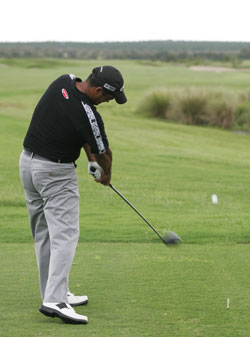 BORDER='1' STYLE='margin-left:10' VSPACE='5' ALT='golf driver shafts'> |
And consistency doesn't have to boring. Golf is about HOW MANY, not HOW FAR and I’ve fitted hundreds of golfers who consequently play better and hit the ball longer, straighter and with greater consistency with a driver built to their optimum length.
Getting the shaft length right for you, is one of the most important and basic factors in club fitting - together with the right grip. If your driver is too long for your golfing ability, it will mean more off-centre hits, resulting in off-line shots and a massive loss in distance - at least a five per-cent loss in distance on tee shot with a driver for every half inch off centre.
So if you're capable of carrying your drives 220 yards, you could be down to 209 yards with a longer shaft. Should you miss-hit by a one inch on that big 460cc driver head, you’ll maybe have a 200-yard drive that could have been 220 yards.
Finally, some words of warnin. Before you clamp your £250 graphite driver into a vice and chop an inch or two off the shaft, you should know that when you shorten any golf club you will reduce its swing weight and change the overall feel of the club. Sorry to dampen your DIY urges, but it’s a job for an experienced club-maker or a skilled pro, they will find the optimum club length for you and build in the necessary compensations into your clubs.
So, just as you would go to a qualified professional coach if you want to improve your technique, seek out an experienced club-fitter if you want to get the most from your equipment.
What's the length of the shaft in your driver? Have you checked it lately? Might you hit it more consistently if it was shorter and more manageable? Give us your feedback on the forum.
John Whitehead, took up golf when he was eight and became a professional when he was 16. He is one the country's most experienced club-makers, based at The Golfers Den, Old Dairy Farm, Upper Stowe, Northants
www.strikerightgolf.co.uk .
IT wasn’t long ago that the average length of a driver was no more than 43.5 inches. But times have changed and when next you look over the clubs in your local pro shop or golf superstore, pay attention to the length of the drivers of your favourite brands.
You’ll find them built to a length of 45 to 45.5 inches which now seems to be the standard length of modern off-the-shelf drivers, regardless of brand. You’d be forgiven for believing that this is not only normal but quite usable for the average golfer. But everything in life - and golf - is not always as it seems.
So what’s the reason for this increase in driver length? It’s certainly not that the average golfer has become taller and more athletic in the last 20 years!
There are two reasons. The first is technical because when graphite became the preferred shaft for drivers, its lightness caused problems on the production lines. It dramatically altered the feel of a 43.5-inch driver, reducing the swing-weight by some nine to 12 points making a men's driver feel more like a woman's.
There where three ways to resolve problem:
1) Return to fitting heavier steel shafts
2) Re-work driver heads by adding weight
3) Leave two inches extra on the shaft
The other reason (apart from technical) is the quest for distance by the club golfer. But first I should mention that US PGA Tour statistics reveal that the average length of a Tour player's driver is 44.5 inches - at least a half to one inch shorter than the average golfer uses to try to hit those elusive fairways on his local course.
So ask yourself: If the best players in the world with their superb swings, ball-striking abilities and healthy desire for distance, are ignoring the longer-shafted drivers sold to the general public, why are club golfers buying them?
In my opinion, it’s all about sales. The competition between club manufacturers for your cash is brutal - and the promise of distance sells golf clubs.
But the promise is based on the rare occasions you manage to hit your longer-shafted driver in the middle of its sweetest spot, while delivering a square club face at your optimum swing speed and tempo.
Do that, and you're going to hit the ball out of sight. But as any pro will tell you, golf is not about rarity, it’s about consistency.
And consistency doesn't have to boring. Golf is about HOW MANY, not HOW FAR and I’ve fitted hundreds of golfers who consequently play better and hit the ball longer, straighter and with greater consistency with a driver built to their optimum length.
Getting the shaft length right for you, is one of the most important and basic factors in club fitting - together with the right grip. If your driver is too long for your golfing ability, it will mean more off-centre hits, resulting in off-line shots and a massive loss in distance - at least a five per-cent loss in distance on tee shot with a driver for every half inch off centre.
So if you're capable of carrying your drives 220 yards, you could be down to 209 yards with a longer shaft. Should you miss-hit by a one inch on that big 460cc driver head, you’ll maybe have a 200-yard drive that could have been 220 yards.
Finally, some words of warnin. Before you clamp your £250 graphite driver into a vice and chop an inch or two off the shaft, you should know that when you shorten any golf club you will reduce its swing weight and change the overall feel of the club. Sorry to dampen your DIY urges, but it’s a job for an experienced club-maker or a skilled pro, they will find the optimum club length for you and build in the necessary compensations into your clubs.
So, just as you would go to a qualified professional coach if you want to improve your technique, seek out an experienced club-fitter if you want to get the most from your equipment.
What's the length of the shaft in your driver? Have you checked it lately? Might you hit it more consistently if it was shorter and more manageable? Give us your feedback on the forum. John Whitehead, took up golf when he was eight and became a professional when he was 16. He is one the country's most experienced club-makers, based at The Golfers Den, Old Dairy Farm, Upper Stowe, Northants www.strikerightgolf.co.uk.
Now read...
Ten of the Best: Game improvement drivers
Ten of the Best: Fairway woods
Premium v budget drivers: Distance test






